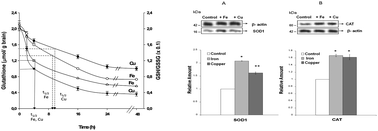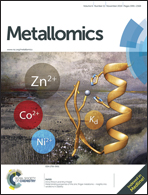Brain antioxidant responses to acute iron and copper intoxications in rats
Abstract
Dose- and time-dependent antioxidant responses to Fe (0–60 mg kg−1) and Cu overloads (0–30 mg kg−1) in rat brains are described by the C50 and the t1/2, the brain metal concentration and the time for half maximal oxidative responses. Brain GSH and the GSH/GSSG ratio markedly decreased after Fe and Cu treatments (50–80%) with a t1/2 of 9–10 h for GSH and of 4 h for GSH/GSSG for both metals. The GSH/GSSG ratio was the most sensitive indicator of brain oxidative stress. The decrease of GSH and the increase of in vivo chemiluminescence had similar time courses. The C50 for brain chemiluminescence, GSH and hydrophilic and lipophilic antioxidants were in similar ranges (32–36 μg Fe g−1 brain and 10–18 μg Cu g−1 brain), which indicated a unique free-radical mediated process for each metal. The brain concentration of hydrophilic and lipophilic antioxidants decreased after Fe and Cu loads; hydrophilic antioxidants decreased by 46–68% with a t1/2 of 10–11 h and lipophilic antioxidants decreased by 75–45% with a t1/2 of 10–12 h. Cu,Zn-SOD and CAT activities and the protein expression were adaptively increased (100–90% after Fe and Cu loads), with a t1/2 of 8–12 h. GPx-4 activity decreased after both metal loads by 73–27% with a t1/2 of 8–4 h with decreased protein expression.


 Please wait while we load your content...
Please wait while we load your content...